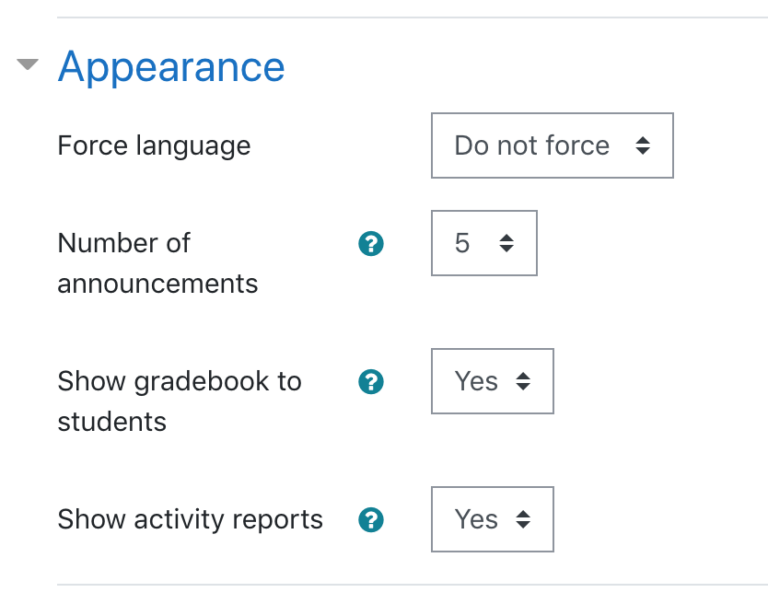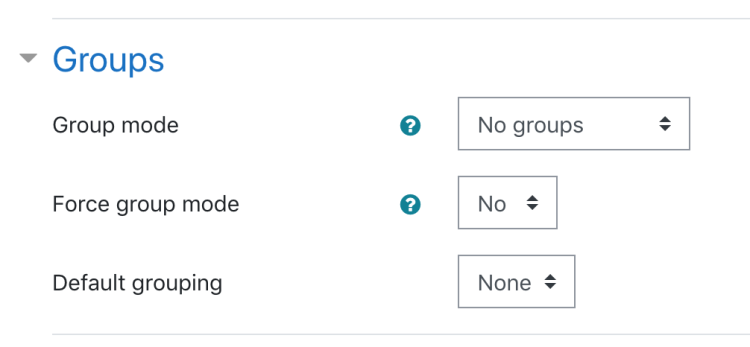Moodle Course Settings Guide
Welcome to the Moodle Support Page for Windsor University Instructors! This resource is here to help you navigate and manage your courses within Moodle. Whether you’re setting up a new course or fine-tuning an existing one, this guide provides clear instructions and practical tips to help you leverage Moodle’s features effectively, ensuring a streamlined and productive teaching experience.
- Course Full Name
- Short Name
- Course Category
- Course Visibility
- Scheduled Course Visibility
- Course Start Date
- Course End Date
- Automatic End Date Calculation
- Course ID Number
- Course Structure
- Format
- Hidden Sections
- Course Layout
- Visual and Language Settings
- Force Theme
- Force Language
- Number of Announcements
- Show Gradebook to Students
- Show Activity Reports
- File Management
- Maximum Upload Size
- PDF Font
- Completion Tracking
- Group Settings
- Group Mode
- Force Group Mode
- Default Grouping
- Role Management and Tagging
- Role Renaming
- Tags
- Custom Course Fileds
- Custom Fields
- Administrative Settings
Table of Contents
Course Full Name
This is the title of your course, which will appear as a link on the course listings page, on the Dashboard, and in various reports. It’s also displayed in the browser’s title bar when the course is open.
Short Name
Institutions often use abbreviated names for courses, such as ENG101 or HIST. Even if your course doesn’t have one, you can create a short name here. It’s used in places where the full course name isn’t suitable, like navigation menus.
Typically, only full course names are displayed in lists. However, administrators can choose to display short names as well by adjusting the settings in Site administration > Appearance > Courses.
Course Category
Administrators may organize courses into categories to make it easier for teachers and students to find what they need. These categories can also be reflected in navigation menus.
Course Visibility
This option allows you to hide your course completely from students. Hidden courses won’t appear in course lists, and even if students have the direct link, they won’t be able to access the course. However, managers, course creators, and teachers, along with users who have permission to view hidden courses, will still see it.
The ability to hide and show courses is controlled by the hide/show courses capability.
Scheduled Course Visibility
If your administrator has enabled specific tasks, the course can be set to automatically become visible to students on the start date and hidden on the end date. Tooltips provide further guidance on how this works.
Course Start Date
This setting impacts how logs and weekly topics are displayed.
For courses in a weekly format, the start date will mark the beginning of the first section. For instance, selecting a Monday start might display “Monday – Sunday” for the first week.
This setting also determines the earliest date from which log activities will be recorded.
This setting doesn’t apply to courses using non-weekly formats like social or topics.
Tips:- If your institution follows a weekly format, consider setting the start date at the beginning of the week, like Monday.
- If your course doesn’t have a specific start date, you can set the date to the previous day and control access through availability settings.
Course End Date
The course end date helps determine whether the course should appear in the list of active courses. Once this date passes, the course may be moved to a “past courses” section on students’ dashboards.
This date is also important for calculating how long course data is retained and may be used in reports that summarize course activity.
Even after the course end date, students can still access the course unless further restrictions are applied.
Automatic End Date Calculation
For courses that follow a weekly format, the end date can be calculated based on the start date and the number of weeks or sections in the course. If you add or remove sections, the end date will automatically adjust. If this option is selected, the end date cannot be set manually.
Course ID Number
The Course ID is an optional field that can be used to match the course with an external system, such as a catalog or database. This ID isn’t visible to students, but it can be useful for administrative purposes, like linking to an external registration system.
Course Structure
Format
Refer to the Course formats section for more details.
Hidden Sections
This setting lets you control how hidden sections are displayed to students. By default, hidden sections are indicated by a small, collapsed area, but students won’t see the contents. This feature can be particularly useful when you want to plan future lessons or hide materials not yet available.
Tip: You can choose to completely hide these sections so students don’t even know they exist until you make them visible.
Course Layout
This setting controls whether the entire course is displayed on one page or spread across multiple pages. It applies to custom sections and weekly formats, as well as any contributed course formats.
Teachers can choose whether to display all sections on a single scrolling page or to show one section per page.
Visual and Language Settings

Force Theme
If allowed by the administrator, you can select a specific theme for your course that differs from the rest of the site. This option lets you customize the look and feel of your course.
Force Language
This setting allows you to enforce a specific language for the course interface, even if students have set a different language preference in their profiles.
Number of Announcements
This setting determines how many announcements from the course’s Announcement forum appear in the Latest Announcements block.
If your course doesn’t require announcements, you can set this number to zero.
Show Gradebook to Students
This option controls whether students can see the gradebook link in the course’s Administration block. If your course doesn’t use grades, it’s a good idea to disable this link. However, students can still see their grades from individual activities, like assignments, even if the gradebook link is hidden.
Show Activity Reports
This setting allows students to view reports on their activity within the course. Keep in mind that enabling this feature may increase the server load, which is why it’s disabled by default.
File Management
Maximum Upload Size
This setting lets you specify the maximum file size that students can upload to the course. The available options are determined by the site administrator.
PDF Font
If text in languages like Arabic, Chinese, or Hebrew doesn’t display correctly in downloaded PDF files, you can choose a different font that supports your language.
Completion Tracking
Completion tracking must be enabled to use activity completion features. Course completion criteria can also be based on these activity completions.
Group Settings

Group Mode
This setting lets you define how groups are used in the course. You can choose “No groups,” “Separate groups,” or “Visible groups.” The selected mode will be the default for all activities in the course.
Force Group Mode
If group mode is enforced at the course level, it will apply to every activity in the course, overriding any individual activity settings.
Default Grouping
If groupings are enabled, you can set a default grouping for activities and resources in the course.
Role Management and Tagging
Role Renaming
Note: In the latest version of Moodle, role renaming has been moved to the Participants section under Course navigation.
Tags
Teachers can add custom or official tags to their courses. Tags help organize content and make it easier for users to find relevant courses.
Custom Course Fields
Custom Fields
If enabled by the administrator, custom fields can be added to courses and configured by teachers in the course settings.
Administrative Settings
Administrators can set default course settings in Site administration > Courses > Course default settings. They can also control the maximum number of weeks or topics available for courses on the site.
Custom fields for courses can be added by the administrator and then configured by teachers within the course settings.



